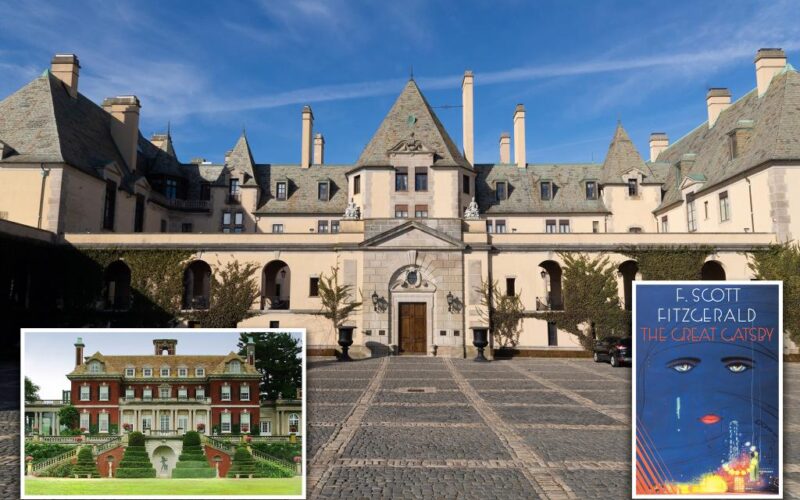Long Island’s Gold Coast still shines — albeit in a more subdued manner than when “The Great Gatsby” was published 100 years ago.
The novel, which is celebrating its centennial this week, is set in the mammoth mansions of the tony North Shore. While some of the colossal homes from the era remain, the atmosphere is less debaucherous than it was in F. Scott Fitzgerald’s day.
In 1924, when Fitzgerald was completing his first draft, the speed limit on state highways was 30 mph, and the Hamptons were a wearisome schlep, still the domain of gnarled fishermen and potato farmers with old Dutch names.
The “it” spots for hotsy-totsy hoopla hugged commuter-friendly villages on the Long Island Sound — where the children and grandchildren of Gilded Age industrial barons played and the Jazz Age’s newly minted tycoons went to purchase respectability.
At its peak, the Gold Coast, which extends from Great Neck to Northport, had roughly 1,200 mansions, almost half of which were set on 50 acres or more. Great families, such as the Vanderbilts, Astors, Guggenheims, Roosevelts, Hearts, and Whitneys, called these huge houses home.
They were egos externalized. Forty to 60 rooms were the norm, and many had upwards of 90. There were over-the-top amenities galore, from lake-sized swimming pools set in formal gardens to equestrian parks and sunken tennis courts.
Today, less than a third of the old mansions remain. Most have been razed to make way for new construction. Of those that still stand, only a few dozen are private residences.
Artist Irene Vultaggio and her husband, Arizona Ice Tea billionaire Don Vultaggio, reside in a sprawling French Chateau-style stone manor immediately next to the Sands Point Lighthouse, which they also own, in North Hempstead.
“I live in Daisy’s house,” Irene told The Post. “My house is the house with the lighthouse . . . So [Gatsby] would look towards my house, and there would be the green light.”
The Vultaggios built the home in the 1990s. The property was previously the site of the legendary Beacon Towers.
By the time “The Great Gatsby” was published in 1925, the house was owned by publishing leviathan William Randolph Hearst. It was demolished in 1945 after Hearst returned the home to the bank for tax purposes.
Despite its lighthouse proximity, Fitzgerald scholars believe it was more likely that the home was the inspiration for Gatsby’s gaudy mega-mansion rather than Daisy’s.
Created for the widowed socialite Alva Smith Belmont Vanderbilt by Hunt & Hunt between 1917 and 1918, the approximately 140-room estate was a “Gothic fantasy,” writes architectural historian Richard Chafee, with “astonishing towers and pinnacles” that borrowed from the medieval palace in Seville.
It “was a colossal affair by any standard,” Fitzgerald writes in the great novel. “It was a factual imitation of some Hôtel de Ville in Normandy, with a tower on one side, spanking new under a thin beard of raw ivy, and a marble swimming-pool, and more than forty acres of lawn and garden. It was Gatsby’s mansion.”
When Baz Luhrmann needed architectural inspo for his 2013 adaptation starring Leonardo DiCaprio and Carey Mulligan, he looked to both Beacon Towers and Old Westbury Gardens, the former estate of steel heir John Shaffer Phipps. But the film was actually shot in Sydney, Australia.
Others contend that Fitzgerald got his big ideas from Oheka Castle, the largest private home in New York and the second largest in the US — behind Vanderbilt’s Biltmore Estate.
Located in the West Hills section of Huntington, the 127-room, 109,000-square-foot behemoth was finished in 1919 by financier Otto Hermann Kahn. In the 1920s, it swung with lavish parties for celebrities and heads of state. In 1939, several years after Kahn’s death, and plagued by debts, it was sold to the New York Department of Sanitation as a “super-de luxe country club” for the department’s 20,000 employees. It was rechristened “Sanita.”
For the last 25 years or so, it’s operated as a hotel and wedding venue. Anthony Weiner and Huma Abedin got hitched there in 2010.
Regardless of where Gatsby lived, according to Vultaggio, the Gold Coast isn’t anything like the champagne-soaked society bacchanalia it was in Fitzgerald’s day.
Rather, it’s where business titans like Ken Langone, Aby Rosen, and Louis Bacon come to truly escape it all.
“It’s quiet,” she said. “I don’t have to impress anybody. I can just live my life under the radar. I’m in my pajamas all day in my garden. If people come here, I tell them I’m the gardener. It’s nice.”
Prices for mansions in the area are equally low-key. At a time when $100 million sales are becoming routine on the East End, a $10 million deal on the Gold Coast is rare.
The median sale price in the area for the last quarter of 2024 was just $1.3 million, according to Douglas Elliman.
Still, when the right home hits the market, it makes an impact, and inventory is limited.
In December, Erchless, a 92-acre, 26-room estate at 75 Post Road in Old Westbury, sold for $21 million — setting an all-time sale record for a residence in both Nassau County and Old Westbury.
The Georgian-style brick mansion was built for Howard Phipps, the son of Henry Phipps, Jr., a partner at Andrew Carnegie’s Carnegie Steel Company, in 1936. It sold with a swimming pool, cabanas, a tennis court, greenhouses and potting sheds, a horse stable, barns, a superintendent’s house, and a chauffeur’s house with a garage.
Most importantly, its award-winning rhododendron garden “is the finest of its kind,” supplying the New York Botanical Garden, said Maria Babaev of Douglas Elliman, who represented the buyer in the Erchless deal.
She noted that while the area is no longer a swinging scene, those buying these properties appreciate the Fitzgerald connection.
“The Gatsby lifestyle was fiction, but on the North Shore, it’s kind of real,” she told The Post. “And the people who purchase these homes are very enthusiastic about old-world charm. They aren’t that different from who was buying here 100 years ago. They want to create a multi-generational legacy.”
Top schools, a low-key atmosphere, and commutability are the major draws to the area. Many of her clients bounce between an apartment in the city, an estate on the Gold Coast, and a summer playground in the Hamptons.
They don’t sacrifice modern creature comforts for legacy living. Buyers of grand old estates typically install cutting-edge technology and vast wellness spaces.
Exclusivity is also a factor, said Maggie Keats, a Gold Coast broker with Elliman. In recent years, she’s sold various local estates — including the $11 million Normandy-style mansion built in the late 1920s by railroad heiress Mary Harriman Rumsey in Sands Point and the $6.5 million Sands Point home of “Stars and Stripes Forever” composer John Philip Sousa.
“There are not a ton of these homes left,” she lamented. “They were broken up over the years, subdivided, demolished for tax reasons or transformed.”
Villa Carola, the former estate of Isaac Guggenheim, is now the Village Club of Sands Point, and Eagle’s Nest, the former home of William K. Vanderbilt, is now the Vanderbilt Museum & Planetarium.
“New homes are beautiful, but these homes were built differently,” Keats said. “There was no expense spared and they have a presence of place because they’ve sat so long on their property. The trees have had a chance to mature. The landscaping is beautiful. The integrity of the build is very special.”
One relic of Fitzgerald’s time is currently for sale at 1985-4 Cedar Swamp Road in Brookville. Known as Haut Bois, it was built in 1916 for architect and Edith Wharton collaborator Ogden Codman Jr. and was inspired by the Palace of Versailles. The seven-bedroom house is asking $14.9 million with Daniel Gale Sotheby’s International Realty.
Also on the market is Mini Oheka — a wedding gift given by Otto Kahn to his son in 1936 and located at 491 Muttontown Road in Muttontown. The nine-bedroom French-style chateau sits on 10.4 acres and is listed for just $3.9 million with Gale.
But if you’re looking for one of Jay Gatsby’s orgies, head further East, Vultaggio asserted.
“I’m Cinderella, and I live in a castle,” she said. “[But] people here aren’t living that crazy life like in the Hamptons. I hate the Hamptons.”








